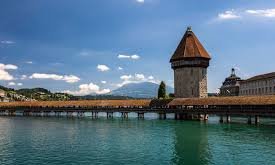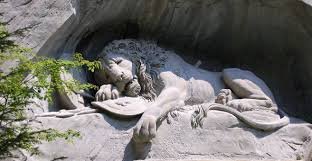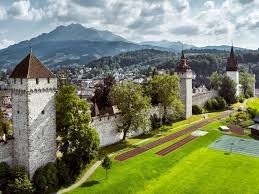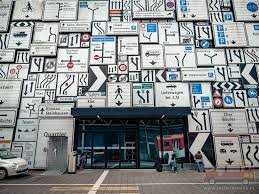Lucerne is a city and municipality in central Switzerland, the administrative seat of the canton of Lucerne and the district of Luzern-Stadt. It is situated on the western shore of Lake Lucerne, on the bay, on both sides of the Reuss River, at the foot of Mount Pilatus.

- The Chapel Bridge and the Water Tower. The oldest covered bridge in Europe is considered the symbol of Lucerne. It was built in the 14th century and was initially part of the city’s defensive system. In the 17th century, it was decorated with panels depicting scenes from the history of Switzerland and the city. Lucerne is particularly famous for its wooden bridges. Today, the Chapel Bridge runs from the Lucerne Theatre on the southern bank of the Reuss River next to the old water tower to the chapel of St. Peter at the Rathausquai. The oldest covered wooden bridge in Europe is considered the symbol of Lucerne. It was built in the 14th century and was initially part of the city’s defensive system. In the 17th century, it was decorated with panels depicting scenes from the history of Switzerland and Lucerne, including the biographies of the city’s patron saint, St. Leodegar, and the patron saint of Switzerland, St. Maurice. The Lucerne Water Tower is distinguished by its crude but attractive silhouette. The 34-meter-high octagonal structure was built around 1300 as part of the city’s defensive walls and has served alternately as a city archive, treasury, prison, and torture chamber. Today, the middle floor houses the meeting rooms of the city’s artillery association. Swifts have been nesting under the tower’s roof for decades. The arrival of these black-and-white birds from their wintering grounds in Africa heralds the arrival of spring in Lucerne.

- Lion monument. Historic monument. The Lion Monument is a proud landmark of the city of Lucerne and a popular attraction. The “Lion of Lucerne” lies in its lair in one of the idyllic parks in the center of the city. The Lion Monument, which is nestled in a rocky grotto in a charming park setting, was unveiled in 1821. The dying lion of Lucerne was sculpted from the living rock of the cliff and commemorates the Swiss guardsmen who died in 1792 during the French Revolution. The most mournful and moving piece of stone in the world invites you to journey back through time. However, this striking stone lion is more than “just” a monument. Depending on your perspective, it can be a memorial, work of art or monument. More information on the historical background and the multi-layered significance of the monument is provided on information boards.

- Musegg Wall. Monumental city walls. The Water Tower, Chapel Bridge and Musegg Wall dominate the historical skyline of the city of Lucerne. However, the best view of the lake basin can be enjoyed from the path that runs along the Musegg Wall. The Musegg Wall and the nine Musegg Towers formed part of the town’s fortifications and today, visitors and locals can walk along many sections of the ramparts. The old natural stone walls provide a valuable and truly special habitat for endangered plants and animals, including jackdaws, common swifts and bats. There is also a Musegg Wall newspaper and guided tours are available. Directly behind the wall lies the Hinter Musegg Farm – a chance to experience farm life in the heart of the city, with a farm shop, eatery and animals. The farm is organic and open stable doors offer visitors a glimpse into species-appropriate husbandry. Children and families can see alpacas, Highland cattle, mini pigs, hens and goats, while also getting a chance to work on the farm. This offer is available to school groups as well. Those wishing to find out more about the animals living here can follow the educational trail and solve a quiz to discover fascinating facts.

- The Swiss Transport Museum. The development of mobility. The Transport Museum building, opened in 1959, is the most visited museum in Switzerland. The history of mobility and communication is documented in the form of exhibitions and theme parks, simulators and interactive stations, as well as films and shows. The Transport Museum includes a wide-ranging exhibition on mobility, the largest in Europe. Over 300 objects on over 20,000 km2 of exhibition space show the development of transport on road, rail, water, air and space. In the locomotive simulator, you can control the train yourself. The museum of communication with an authentic radio and television studio documents the development of mass media technology. The Swissarena presents a 200 m2 bird’s eye view model of Switzerland, which you can walk around. Additional offers such as a planetarium, IMAX and Swiss Chocolate Adventure complement the offer of the Transport Museum.

- Pilatus. Lucerne’s local mountains. In the heart of Switzerland, on Lake Lucerne, lies the impressive Pilatus peak. The Lucerne mountain with its red dragon is one of the most popular excursion destinations in the region. Unforgettable mountaintop experiences are provided by cable cars and mountain railways, hiking trails, the Dragon World and an adventure park. Pilatus is located in central Switzerland, south of Lucerne and on Lake Lucerne. This impressive mountain range is a real colossus, with its spectacular cable cars and mountain railways, fantastic views and a wide range of leisure activities. Your Pilatus adventure can start at the Pilatus shop in Lucerne – the one with the red dragon. Whether you do it here or online, it is worth booking a place on a ship and a cable car or mountain railway. The Pilatus Kulm can be reached in 60-80 minutes. Whether you’re admiring the view from the lookout, the viewing deck or the Dragon Trail, the views from here are absolutely spectacular. Other attractions include the interactive Dragon World tour, two mountain restaurants and an ibex safari – available to book if you’re planning to spend the night at the top.

- Lake Lucerne. Beautiful fjord landscape. Lake Lucerne captivates with its beauty and diversity. The lake is filled with deep blue water and surrounded by the Rigi and Pilatus peaks, and on its shores are picturesque villages and the city of Lucerne: This unique combination is a unique source of inspiration. Lake Lucerne is located in central Switzerland, in the cantons of Uri, Schwyz, Unterwalden and Lucerne. It is one of the most popular tourist destinations in Switzerland due to its varied landscape and numerous attractions. Discover Lake Lucerne. The city of Lucerne and Lake Lucerne simply go together. After a walk through the city, you can admire the lake from the deck of a boat: several excursion boats leave from the train station every day. Enjoy the wind from the lake and be inspired by the other landscape features. Lake Lucerne is characterised by its changing landscape from one bay to another, as well as by many mountain railways leading to popular excursion mountains such as Rigi and Pilatus. Boat trips and water sports. All aboard! The pearls of the Lake Lucerne fleet are the “Diamant” and the nostalgic steamers. Experience unforgettable moments on a sightseeing tour or a sunset tour. The range of water sports is as diverse as the landscape itself. Around the lake you will find many rental shops and competent guides for sailing, windsurfing, kayaking, stand-up paddle boarding and diving. Or you can spread out your towel at one of the many available swimming spots.

